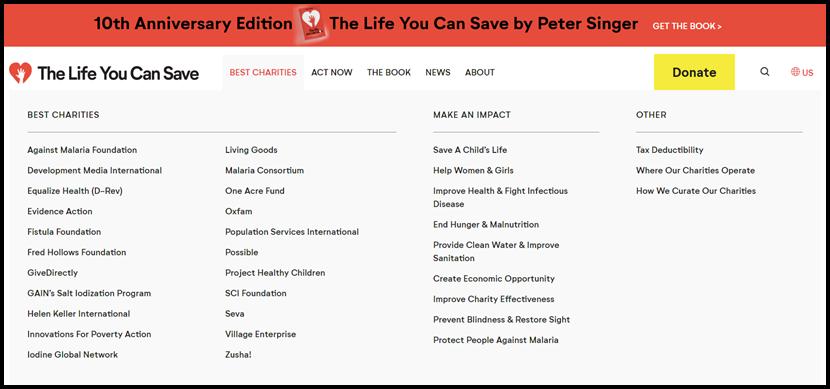
9 minute read
6. Learning
6
Learning
The interventions described in the last section represent a promising starting point for a broader learning agenda at The Life You Can Save. However, the success of any behavioral intervention is dependent upon the specific context that it is implemented in. Creating the optimal intervention for The Life You Can Save’s unique context requires constant evaluation and adaptation. In short, to get the most out of behavioral interventions, The Life You Can Save needs a long-term learning strategy.
Figure 6.1 shows that, in behavioral science, learning is an ongoing process. It begins with defining and diagnosing a behavioral bottleneck and researching past studies conducted on similar topics in similar contexts. Using that information, interventions are designed to address the behavioral bottleneck. The most promising interventions are implemented and their results are evaluated to determine what works best among the set. Adapting the best intervention, or parts from several interventions, is key to long-term success. Periodically, the behavioral bottleneck should be reexamined to determine if the implemented intervention is still working as intended or if the behavioral bottlenecks need to be redefined and rediagnosed, starting the process again.
Consider the example of the email invitation to share the book intervention proposed in the last section. Evaluating the intervention may find that the most effective part of the intervention is the salient reminder to share the book, not the reciprocity or community building frames. In that case, an adaptation may be that The Life You Can Save continues to use email invitations to share the book, but
Figure 6.1 Behavioral Science Learning Is an Ongoing Process
Source: World Bank. 2015. World Development Report 2015: mind, Society, and Behavior. Washington, DC: World Bank. doi: 10.1596/978-1-4648-0342-0.
instead does so surrounding highly-salient events or holidays, such as campaigns around giving season, end of the school year/beginning of summer, or birthdays. By continually redesigning the intervention based on evaluation results, The Life You Can Save can maximize its effectiveness for their own operations and contribute to the body of behavioral science knowledge.
Figure 6.2 Options Under The “Best Charities” Navigation Menu

Currently, The Life You Can Save’s website is a trove of information on Singer’s ideas, the effective altruism movement, and the curated charities. This is great for motivated users who are knowledgeable about effective altruism; The Life You Can Save provides them a real service by conducting research and making it available publicly.
Our Recommendations for Long-Term Website Design
We conducted a market segmentation analysis of The Life You Can Save’s current users. Users include people who already have exposure to or are sympathetic to effective altruism. However, in keeping with The Life You Can Save’s unique place within the effective altruism community, the organization also appeals to people without any prior knowledge of effective altruism or Singer’s ideas. These two different broad categorizations of users require different strategies to appeal to them. However, this level of detail can be intimidating for new users. With so many options, a new user can be intimidated and decide to leave the website. This is the behavioral paradox of choice discussed many times in this report.
One example is the “Best Charities” navigation menu, shown in Figure 6.2. It offers three broad categories (“Best Charities,” “Make An Impact,” and “Other”), with multiple options under each. All told, this single menu offers 34 sub-options under the broad categories. Confronted with this number of possibilities, only the most motivated users will quickly find their way to where they intend to go.
Broadly, our recommendation for a longterm website design is to simplify pages
and options to make it clear what the
user is expected to do on that page. This will highlight The Life You Can Save’s excellent and persuasive content while making it easier for users to move through the website to find the content they want. Several specific recommendations related to this are below:
Create a single “Donation” landing
page. Currently, The Life You Can Save’s website has many different options for donations of various types. We propose to collect the different donation options on a singular “Donation” landing page, as a means of simplifying the choice architecture.
Organize charities by cause. Currently charities are listed by name, although only few of the charities are widely known (ex. Oxfam) or have a descriptive name (ex. Against malaria Foundation). Conversely, website visitors might be more likely to have some knowledge of specific causes (ex. malaria, reproductive health) and which causes they are passionate about. The Life You Can Save should present their curated charities by cause, similar to the current “Make An Impact”/“Causes To Support” page, to simplify the choice architecture and better align with prospective donors’ identity.
Include links to social media accounts
on the book download page. Right now, after downloading Singer’s book, website visitors are encouraged to donate. However, this is a relatively costly action that people may not be willing to do early in their relationship with The Life You Can Save. Instead, the book download page should prominently include links to follow The Life You Can Save on social media in order to start a longer-term relationship with the visitor. This capitalizes on the reciprocity norm felt by many people after receiving a gift by asking for something costless (following social media accounts) in return.
Optimize website design to maximize
attention to key information. Like many modern, visually appealing websites, The Life You Can Save’s website is built from modules that “stack” on each other. The order of these modules is important, as user experience research finds that people are less likely to see content further down a page, and that users that do see that content are likely to be different from the “average” user. The Life You Can Save should experiment with the optimal order of modules, especially near the top of pages with high traffic (such as the “Best Charities” page and the homepage). What constitutes the “optimal” order is not objectively clear, and is likely to change over time. However, The Life You Can Save’s priority content, such as a link to download the book and social media accounts, should be prominent and near the top of the page.
Anchor donations using common
consumption items. As explained in the interventions section, anchoring donations using common consumption items (such as a latte a week) can be an effective way to both increase donations and to spread Singer’s ideas. Getting the right anchor that both resonates with the potential donors’ identity and that maximizes the average donation requires additional research. For example, there
is a big value difference between giving up a latte a week for a year ($208) and a latte a day for a year ($1,460). However, fewer people might identify with a latte a day splurge than people identify with a latte a week. Other anchoring options should be explored, as well. keeping with the Google Analytics finding that The Life You Can Save website visitors are relatively more likely to search for travel and accommodations, one option may be giving up one vacation a year. But, how to value that vacation? It is possible that only a small share of website visitors can identify with giving up an expensive international vacation, while anchoring to a more modest domestic vacation might leave money on the table.
Our Recommendations for a Long-Term Social Media Plan
Currently, The Life You Can Save does not have a comprehensive social media strategy. As a first step toward creating one, we recommend using social
media to study slogans and foster a
sense of community. This leverages the unique advantages of social media while providing valuable insights to inform other aspects of The Life You Can Save’s communications.
Use social media to informally poll the resonance of different slogans.
TLYCS currently uses several different messages, such as personal best, smart giving simplified, you don’t have to be brave to save lives, the head and the heart, etc. Social media polls can be run through posts on Facebook or Twitter, as well as on stories on Instagram. While this approach remains a basic, informal method of testing, and would be constrained by its nature of only testing within a population of highly-engaged followers, it could provide a good baseline on which to justify future testing and refine potential hypotheses for A/B testing on the website. This type of testing is free and easy, and could also spark donor engagement with these platforms.
Use the social media channels in a
more “social” way. This will increase engagement with and between donors on the platform to bolster the sense of community on TLYCS social media platforms. We recommend doing so through highlighting more donors testimonials, engaging followers in live virtual discussions with senior TLYCS members or Singer on timely effective altruism topics, or posting discussion or open-ended questions on stories to provide followers the opportunity to engage with these platforms on a more personal basis.
As previously mentioned, the analysis we conducted and interventions we suggest are only meant as a starting point for integrating behavioral science into The Live You Can Save’s operations.
Continuing in-house behavioral research and evaluating interventions will maximize the value of the insights
from this project. We offer some suggestions about how to conduct tests to support a culture of learning at The Life You Can Save.
For future social media testing, we would recommend a period of at least one week per concept tested, in order to provide a statistically significant number of posts within a testing window. The challenge with testing over social media is balancing the need for control posts with a reticence to post redundant content. One avenue to address this would be through social media advertising, which is more conducive to traditional A/B testing.
Alternatively, The Life You Can Save could vary posts slightly over different social media platforms, and then could compare posts to average post performance on each site. Further analysis could determine if any marginal differences could be attributed to more targeted behavioral interventions, for example, posting the same content and framing with different photos attached on each social media platform.
The website naturally lends itself to A/B testing, which is a low-cost way to rigorously evaluate alternatives against each other. Similarly to social media testing, we suggest a testing window of at least one week per concept to provide a large enough sample of visitors to the website. Testing each concept does not mean only one alternative against a control; a single A/B test can include multiple alternatives at once. The number of possible alternatives is limited by expected web traffic. The testing window should be set so that each alternative is expected to get a large enough sample to detect a reasonably small effect size.
While multiple alternatives are possible at once, only one test should be run at a time, and designers should also consider if there are other events (such as oneoff fundraisers) happening at the same time. These could all change either the composition of users on the website or the way that they interact with the website, meaning the sample is not representative of a typical user.






